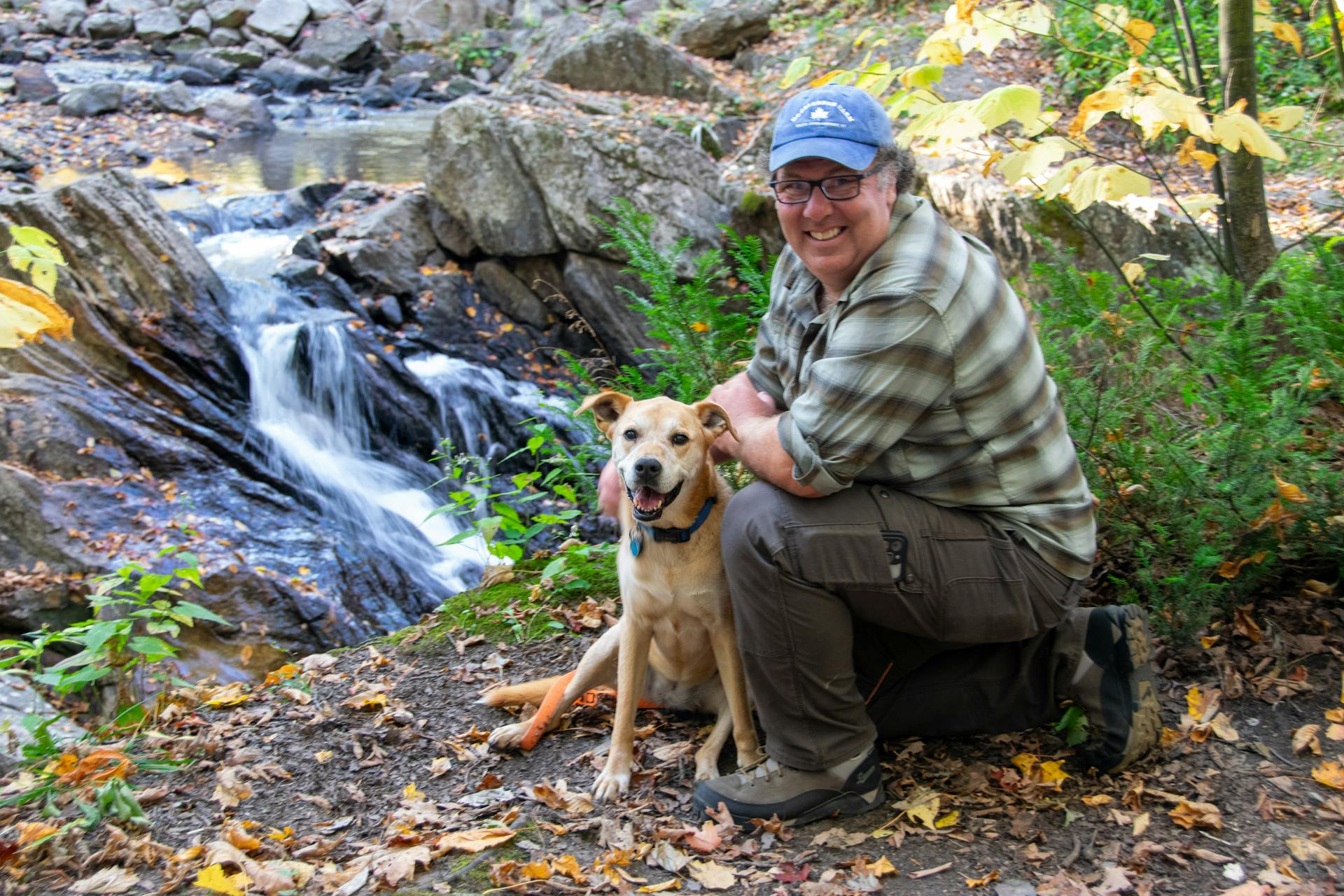
The Appalachian Trail is a 2,190-mile long hiking path that spans from Georgia to Maine, passing through 14 states. It's a challenging yet rewarding adventure for both humans and their furry friends.
The trail is open to dogs, but they must be kept on a leash no longer than 6 feet. This is to protect both hikers and wildlife.
To prepare for the trip, it's essential to research the best time to hike with your dog. The best time is typically from April to October, when the weather is mild and the trail is less crowded.
Recommended read: How to Have a Dog When You Work Full Time
Preparing for a Hike
Start by getting your dog accustomed to shorter hikes to build up their endurance. This will also give you a chance to test your equipment and see how your dog handles different terrains and elevations.
Take the time to familiarize yourself with your dog's preferences and capabilities. You can use these smaller hikes to track how often they need to stop for a bathroom break, how much water they consume, and if they're enjoying themselves.
Discover more: Dog Hikes East Bay
Don't push your dog to hike for too long or at too high an elevation if they're not comfortable with it. Be honest with yourself about their limits and plan accordingly.
Test any new purchases before beginning your expedition to save yourself trouble along the way. This will help you narrow down your packing list and ensure that your dog stays happy and comfortable.
Take into account your dog's needs when planning your hike, and be prepared to make sacrifices if necessary. This might mean skipping dog-unfriendly hotels or hostels, or stopping your hike early if your dog is struggling.
A different take: How to Hike with Two Dogs?
Physical and Behavioral Considerations
Hiking the Appalachian Trail with a dog requires careful consideration of both physical and behavioral factors. The trail's elevation gain and loss is equivalent to hiking to Mt Everest and back from sea level sixteen times, making it a major undertaking that will demand great physical effort from both you and your dog.
Before embarking on the journey, it's essential to prepare yourselves adequately, both physically and mentally. This includes training your dog to respond to basic commands, which will make any hike easier.
Here are the basic commands you and your dog should perfect before setting out: SitStayLeave ItDownHeelA recall command (such as ‘come’ or ‘here’)
Your Physical Ability
Hiking with your dog can be a major undertaking, especially considering the equivalent elevation gain and loss of the trail is the same as hiking to Mt Everest and back from sea level sixteen times.
It's crucial to prepare yourselves beforehand, as completing the trail will take great physical effort from both you and your dog.
Behavioral Training
Behavioral Training is a crucial aspect of hiking with your dog. A well-behaved dog will make any hike easier.
To ensure your dog behaves well on the trail, it's essential to perfect basic commands. These include Sit, Stay, Leave It, Down, Heel, and a recall command like 'come' or 'here'.
These commands are not just for the sake of obedience; they can also help prevent accidents and ensure your dog's safety. For example, a recall command can help you locate your dog if they get lost or distracted.
Practicing these commands before your hike will save you stress and make the experience more enjoyable for both you and your dog.
Here are the basic commands you should work on with your dog:
- Sit
- Stay
- Leave It
- Down
- Heel
- A recall command (such as ‘come’ or ‘here’)
Leash Requirements
Dogs are only required to be leashed on parts of the trail that pass through National Park Service-administered lands.
Personally, I preferred to keep my dog on a leash for the majority of our partial trail hike. I wanted to be able to manage their safety and behavior around the surrounding wildlife.
You'll see other people and dogs out on the trail, and it's best practice for dogs to be leashed. This keeps both your dog and other hikers comfortable.
Even if your dog is friendly, you can't guarantee all the dogs you pass will react in the same way.
Gear and Equipment
When it comes to packing for a hike with your dog, testing new gear before hitting the trails is crucial. It will save you a lot of trouble along the way if you find that certain pieces just aren't working or are adding too much excess weight to your packs.
To narrow down your packing list, consider the essentials listed below. This gear played a massive part in keeping our dog happy and comfortable on our shorter trek.
The Groundbird Gear – Roll top saddle bags are a great option for carrying your dog's gear. A high-quality leash or harness is also essential, and it's best to stick to the style of equipment your dog is used to.
Here's a list of some of the gear we found to be most useful on our hike:
- Pack: Groundbird Gear – Roll top saddle bags
- Leash: Ruffwear Roamer leash
- Booties: Mushers Booties
- First Aid: Tweezers, Benadryl, vet wrap
- Bear Bell: Custom made
Gear:
Gear can be overwhelming, especially when planning a hike with your dog.
The best way to narrow down your packing list is to test any new purchases before beginning your expedition. This will save you a lot of trouble along the way if you find that certain pieces just aren’t working or are adding too much excess weight to your packs.
For a minimum, you'll want to bring along the following items: a pack, food, water/food bowl, leash, booties, sleeping pad, blanket, first aid kit, and paperwork. You can see a more detailed list of dog gear below.
Booties
Booties are a must-have for any hiker's furry friend, especially on rough and rocky terrain like the Appalachian Trail.
You'll want to break in any booties on a short hike first to ensure a smooth transition for your dog.
The initial adjustment period can be tricky, so be patient with your dog as they learn to balance in their new footwear.
If your dog refuses to wear booties, it's a good idea to pack some paw moisturizer or protection cream for extra protection.
Disposable Bags
Disposable bags are a must-have for any dog owner hitting the trails. They'll come in handy on shorter trails and during stopovers.
You'll need to consider how you'll transport these bags, as they'll add bulk to your backpack. Will your dog be willing to carry their own pack with gear inside?
Intriguing read: San Diego Hiking Trails Dog Friendly
Burying doggy waste a few meters from the trail is the way to go when you're out on the trail. This is just common etiquette for dog owners to follow.
You may need to account for added rest stops and extra water if you're planning on having your dog pull their own weight.
First Aid Kit
A well-stocked first aid kit is crucial for any adventure, including those with your furry friends.
You can find a full list of our first aid kit essentials for dogs here, just like for hikers.
A first aid kit for dogs should include essentials like bandages, antiseptic wipes, and tweezers.
These items can help you address common issues like cuts, scrapes, and even tick removal.
For more insights, see: Dog First Aid Kit Hiking
Leash or Harness
You'll want to consider upgrading your current leash or harness for a high-quality one that your dog is used to. This will make a big difference in their comfort and safety on the trail.
A good leash or harness is essential for managing your dog's behavior and safety, especially when encountering bears, snakes, or other wildlife. You'll want to choose one that suits your dog's size and personality.
If you're planning to hike with your dog, it's best to stick with the style of equipment they're used to. This will make it easier for them to adjust to their new gear.
See what others are reading: Breeds of Dogs in a Dog's Purpose
Logistics and Etiquette
Regular trail etiquette applies to dogs and hikers while on the A.T. This means being mindful of your surroundings and respecting other hikers and wildlife.
Consider packing disposable doggie bags, which will come in handy on shorter trails and during stopovers. You'll need to bury doggy waste a few meters from the trail.
If your dog will be carrying their own pack with gear inside, factor in added rest stops and extra water to ensure they stay hydrated and energized.
For your interest: Will Hawks Attack Small Dogs
ID Tags
Losing your dog on the trail is a nightmare scenario, but an up-to-date, clearly printed ID tag on your dog’s collar can make all the difference.
ID tags are a must-have for any dog owner who hikes with their pup.
Accessing the Trail
The Appalachian Trail is accessible by bus, train, and car from over 500 public points, so you've got plenty of options for getting to the trailhead.
You'll need to arrange access via your own vehicle or a support person, especially since you'll have your dog in tow.
Etiquette
Regular trail etiquette applies to dogs and hikers while on the A.T. This means being mindful of your surroundings and respecting other hikers.
Disposable doggie bags are a must-have on shorter trails and during stopovers, as they'll come in handy for collecting dog waste. You can then bury the waste a few meters from the trail.
Consider how you'll transport the doggie bags and other gear, as this will impact your hiking experience. Will your dog be willing to carry their own pack, or will you need to factor it into your backpack?
Always leave no trace and bury any waste or take it away in a doggy bag when possible. This will keep your dog safe and ensure a pleasant experience for all hikers.
You may need to account for added rest stops and extra water if your dog is pulling their own weight and carrying gear. This is especially true on longer trails.
For your interest: Rottweilers in Need
Food

You'll want to plan your dog's food carefully for a thru-hike or trail adventure. It's crucial to ensure they get enough nutrients to sustain them.
Your dog will be using substantial amounts of energy on the trail, so choose a high-quality dog food that meets their needs. A good brand will be readily available during your in-town stopovers.
A sudden change in your dog's diet can cause issues like bloating, diarrhea, and vomiting. Introduce any dietary changes well in advance of your trip to prevent this.
Remember, you won't be able to carry six months' worth of food on you, so select a brand that's easily accessible along the way.
Financial and Time Commitments
Hiking the Appalachian Trail with a dog requires a significant financial investment. The average hiker spends over $1,000 a month, covering expenses like accommodation, equipment replacement, and replenishing supplies.
You'll also need to consider costs for your furry companion, such as boarding your dog while you're on the trail or medical care in case of an emergency.
Financial Commitments

As you plan your thru-hike, it's essential to consider the financial commitments you'll need to make. The Appalachian Trail Conservancy found that the average hiker spends over $1,000 a month.
This covers stop-offs and accommodation in local towns, equipment replacement, and the replenishment of supplies.
Trail May Take Too Long
The trail may take too long, especially if you're operating under time constraints like we were. We found that even a few days on the Mau-Har Trail Loop in Virginia was a great teaser for the rest of the trail.
There's no need to feel like you're missing out if you can't complete a full thru-hike. Each state has options like the Mau-Har Loop to choose from.
We chose to spread our hike over two nights to enjoy ourselves more, and it was a much better pace for our dog too, as the terrain was quite rocky.
Hiking Options and Planning
Planning your hike can be overwhelming, especially when you need to accommodate your dog. The Appalachian Trail's list of information is as long as the hike itself.
It's essential to break down the key points and know what you absolutely must know before planning your hike. This includes considering your dog's needs and limitations.
To prepare your dog for the hike, start with shorter hikes to check their limits and build up their endurance. This will also give you a chance to test your equipment.
Planning Your Hike
The Appalachian Trail is a massive undertaking, and planning your hike can be overwhelming, especially when you have to consider your dog's needs.
The average hiker takes anywhere between five and seven months to walk the entire trail from start to finish.
It's essential to break down the key points and know what you absolutely must know before planning your hike, as the list of information available is almost as long as the hike itself.
You should start by familiarizing yourself with your dog's preferences and capabilities, and use shorter hikes to track their needs, such as how often they need to stop for a bathroom break and how much water they consume.
Be honest with yourself about your dog's limits and whether they can handle hiking for extended periods or carrying their own pack.
The more experience you and your dog have beforehand, the better equipped you'll be to deal with unexpected scenarios on the trail.
Hiking the Appalachian Trail vs Short Section Hikes
Hiking the Appalachian Trail vs Short Section Hikes is a big decision to make. If you're looking for a once-in-a-lifetime experience, completing the full thru-hike of the Appalachian Trail will certainly scratch that itch.
You'll need to plan ahead and consider the time commitment required, which is typically around 5-7 months. Before planning a full thru-hike, you will need to look at your schedule and make sure you have enough time off work or school.
If you only have a short period of time, short section hikes might be a better option for you. You can still experience the beauty of the Appalachian Trail without having to commit to a long thru-hike.
Take a look at this: Off Leash Hikes Bay Area
Frequently Asked Questions
How far is too far for a dog to hike?
For medium-to-large dogs, hiking more than 20 miles a day can be excessive, while smaller breeds should stick to shorter, slower walks to stay safe. The ideal distance depends on your dog's size, breed, and conditioning level.
Is it safe to hike the Appalachian Trail alone?
Hiking the Appalachian Trail alone can be risky, even with a partner or dog; it's essential to remain vigilant and trust your instincts for a safe experience
Sources
- https://dogsplorer.com/hiking-the-appalachian-trail-with-a-dog/
- https://www.wilderdog.com/blogs/weeklywoof/the-official-backpacking-with-your-dog-checklist
- https://dogsthathike.com/thru-hiking-with-a-dog/
- https://thetrek.co/appalachian-trail/dog-survived-thru-hike-keeping-healthy/
- https://thetrek.co/hiking-with-a-dog-part-2/
Featured Images: pexels.com


